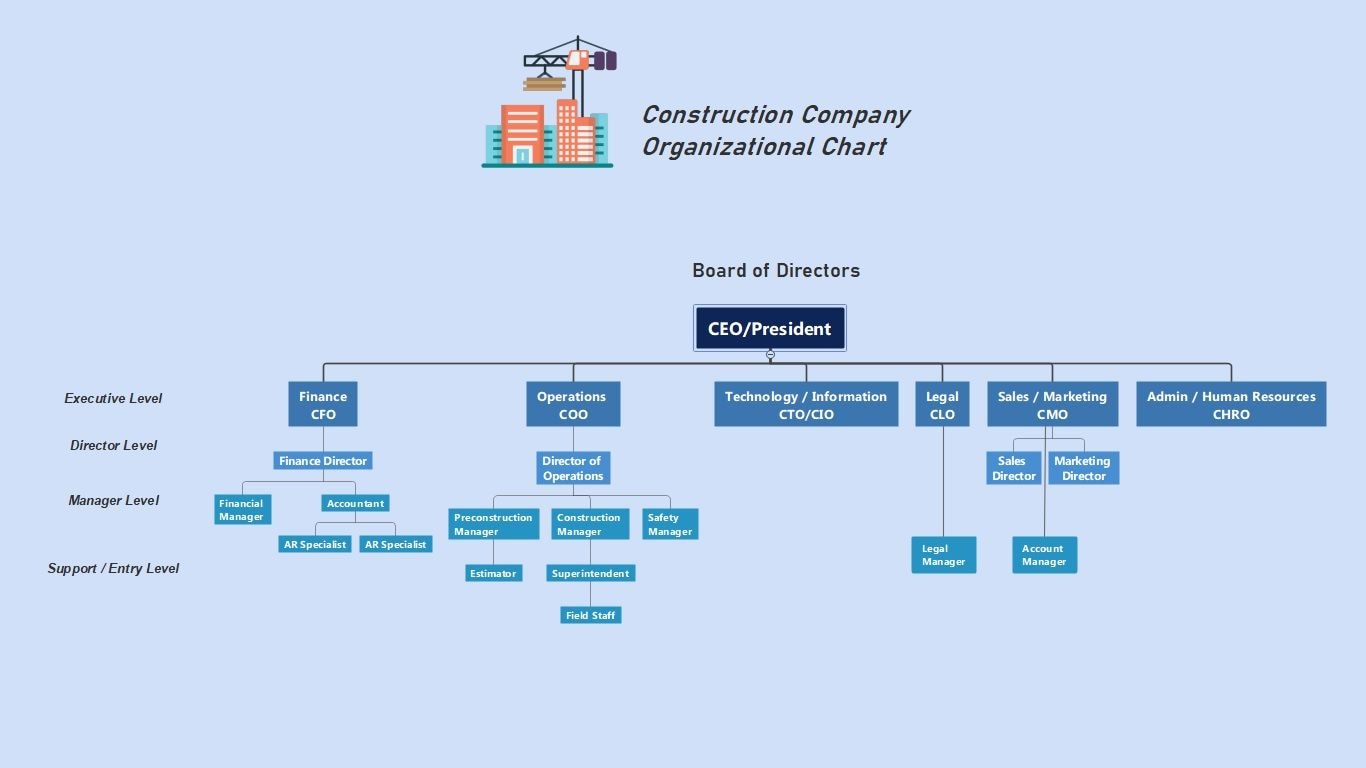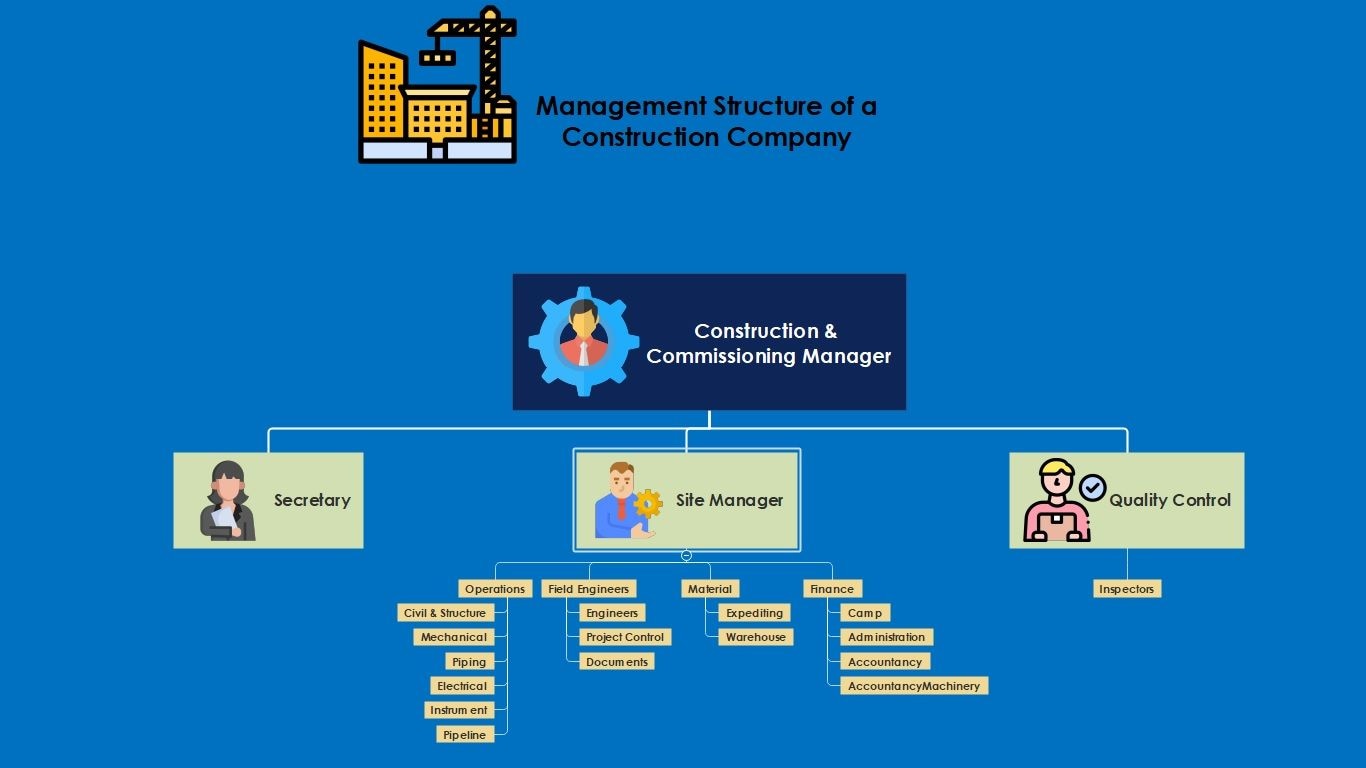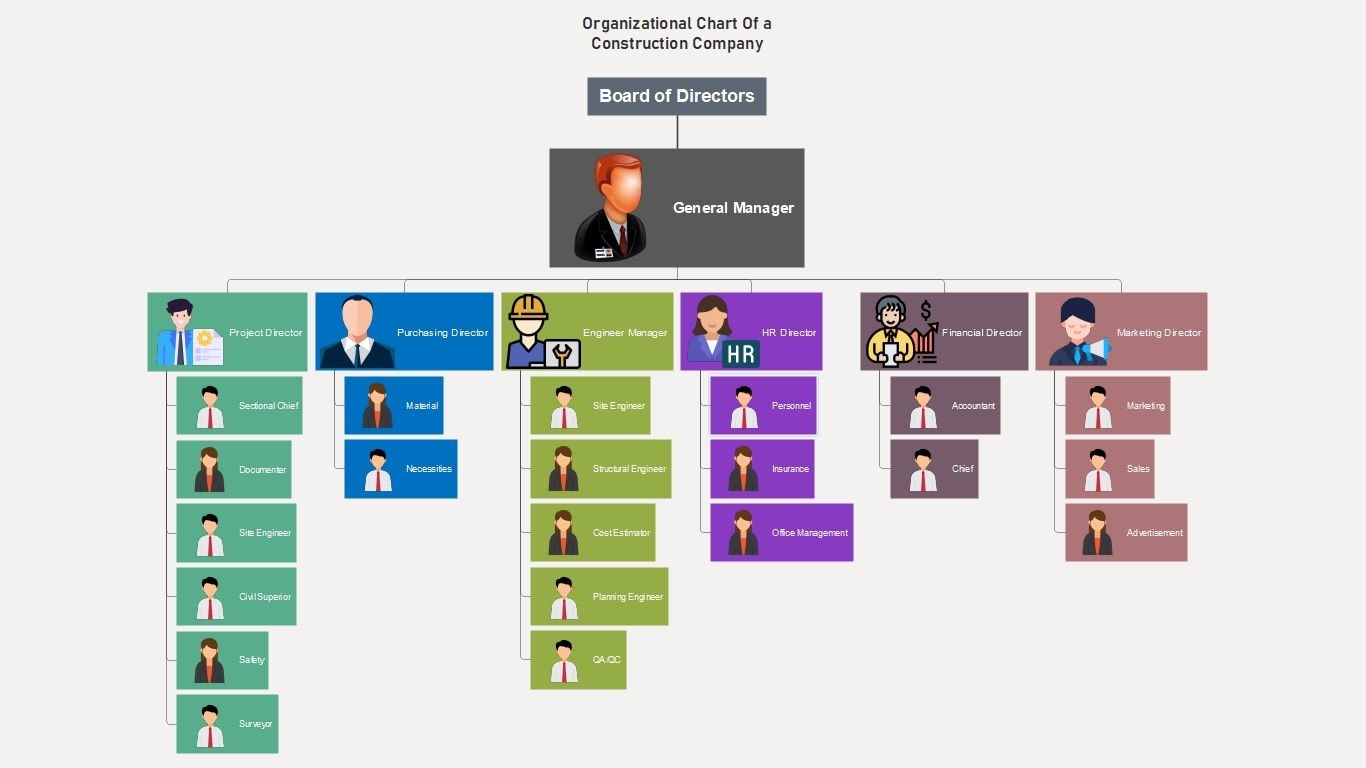Having a well-designed organizational chart is crucial for the success of any organization. It serves as a visual representation of the hierarchy within a company. An organizational chart outlines reporting relationships, roles, and responsibilities. It also provides a clear roadmap for effective communication, decision-making, and workflow.
This article provides tips for creating an effective construction company organizational chart. The page will also discuss 3 examples of construction organizational charts used in the industry. Dive in and unlock the potential of your construction site's hierarchy chart.
In this article
What is a Construction Company Organizational Chart
Organizational charts play a crucial role in establishing clarity and structure. A construction site hierarchy chart includes titles, employee names, and reporting lines. They also state the levels of authority and the chain of command.
Below are three examples of a construction firm's organizational chart as a reference. They illustrate the structure and relationships within the construction company.
Note:
All templates below are from Wondershare EdrawMind and are free to download. You can download one or all and use it directly. Wondershare EdrawMind is a quick and easy tool for making an organizational chart. You can download and use it directly.
Hierarchical Construction Company Organizational Chart
This organizational chart structure follows a hierarchical model found in most construction companies.
At the top level of this chart is the Board of Directors. The CEO/President is next. The executive level includes
- CFO (Chief Financial Officer),
- COO (Chief Operating Officer),
- CTO/CIO (Chief Technology Officer/Chief Information Officer),
- CLO (Chief Legal Officer),
- CMO (Chief Marketing Officer),
- and the CHRO (Chief Human Resources Officer).
At the Director level, directors are responsible for specific areas like Finance, Operations, and Sales Marketing.
At the manager level, managers are responsible for specific functions like the Financial, Accountant, Preconstruction, Construction, and Safety Managers. Each position oversees their respective areas of expertise.
The last level will be the employees. They take up 90% of the company's labor and are responsible for the basic work of the company. They will support the managers.
Overall, this organizational chart structure establishes clear reporting lines. It has defined roles and responsibilities and ensures efficient decision-making. It reflects a functional approach to managing the construction company's operations. There are also specialized roles supporting the broader goals of the organization.
2. Functional and Hierarchical Organizational Structure of a Construction Company
This organizational chart structure depicts a construction company with a hierarchy and functional divisions.
At the top of the organizational chart is the Construction and Commissioning Manager. This serves as the highest-ranking position responsible for overseeing construction projects.
There are three key positions: Secretary, Site Manager, and Quality Control.
- The site manager is responsible for every aspect of the company.
- The secretary will assist the manager with the company errands.
- The head of quality control will supervise the quality of the construction. It's an independent department. Quality Control has Inspectors under it.
What functions will the manager supervise and manage? Everything relates to construction.
- Operations: Have divisions based on specialties such as Civil and Structure, Mechanical, Piping, Electrical, Instrument, and Pipeline. They indicate specific areas of expertise and responsibilities within the construction process.
- Field Engineers: Support the construction operations.
- Material: Includes roles such as Expediting and Warehouse.
- Finance: Comprises sub-departments like Camp, Administration, Accountancy, and Machinery
This organizational chart structure provides a clear hierarchy. It outlines the various departments and positions within the construction company. This kind of chart allows for efficient communication and effective coordination of activities.
3. Functional Construction Company Organogram
This last functional chart consists of 6 departments.
Like the first, the organizational chart starts with the Board of Directors. Below the Board of Directors is the General Manager.
Directly below the General Manager, there are 6 departments represented by directors
- Project,
- Purchasing,
- HR,
- Finance,
- Marketing,
- Engineer Manager.
When there's a project, the Project managers will take care of the major part of the project: construction. And other departments will be there to help, support, and supervise the project managers:
This chart showcases a construction company with various departments and positions. The inclusion of specialized roles in this chart is helpful because it reflects the diverse functions and expertise required in the construction industry.
Why does an Organizational Chart in Construction Companies matter
Organizational charts offer valuable advantages to construction companies. Here are some of them below.
Clear Communication
Organizational charts in construction companies facilitate clear communication. They visually illustrate reporting lines, roles, and responsibilities. This clarity enhances collaboration, reduces confusion, and improves efficiency.
Effective Decision-Making
Organizational charts provide a comprehensive overview of the organizational structure. This understanding helps identify bottlenecks, streamline processes, and allocate resources effectively.
Efficient Resource Allocation
Visually representing positions and departments aids in efficient resource allocation within construction companies. The charts assist in identifying gaps, and workloads, ensuring the right personnel are assigned to the appropriate tasks.
Part 3: How to Create Construction Company Organizational Charts
Creating a construction company organizational chart is a breeze with tools like Wondershare EdrawMind.
The app provides the tools and flexibility to bring your construction company's organizational structure to life. Whether you need to depict hierarchies, roles, or departments, EdrawMind has it.
EdrawMind offers several powerful capabilities for creating construction company organizational charts:
- Flexible Template Library: EdrawMind provides a rich collection of pre-designed templates for creating org charts. These templates offer various styles, layouts, and designs to choose from.
- Drag-and-Drop Functionality: You can create organizational charts by dragging and dropping elements onto the canvas. This makes adding and customizing the chart according to specific requirements easy.
- Customizable Styling Options: EdrawMind offers extensive styling options. You can choose from various fonts, colors, shapes, and line styles to match your company's branding or personal preferences.
- Collaboration and Sharing: You can collaborate on organizational charts in real-time. Multiple team members can work together, making simultaneous edits and updates. This ensures seamless collaboration and eliminates version control issues. Users can share charts easily with colleagues or stakeholders for feedback or review.
- Integration and Exporting Options: EdrawMind allows users to export organizational charts in various formats. You can export to PDF, image files, or even Word documents. This enables easy sharing within the construction company or with external stakeholders.
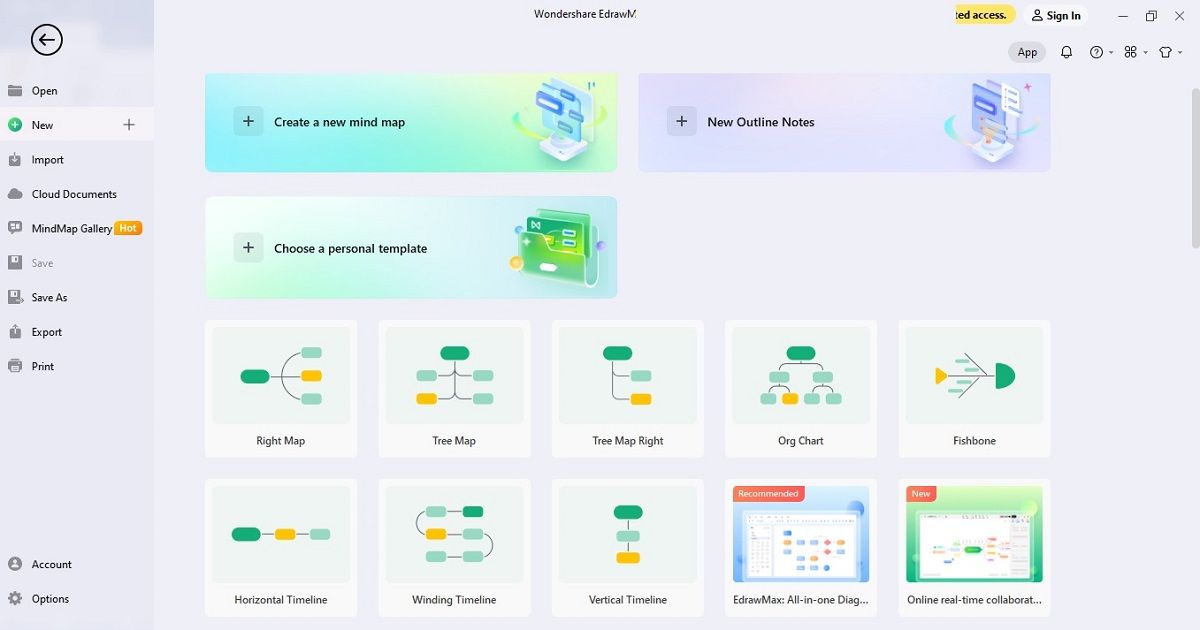
Steps To Create a Construction Company Organizational Chart Using EdrawMind
Here are the steps to effortlessly build a construction company org chart using EdrawMind.
Step 1:
Download and install EdrawMind. Click the Org Chart button to start with a blank canvas. Alternatively, you can also choose a suitable template from other users by browsing MindMap Gallery.
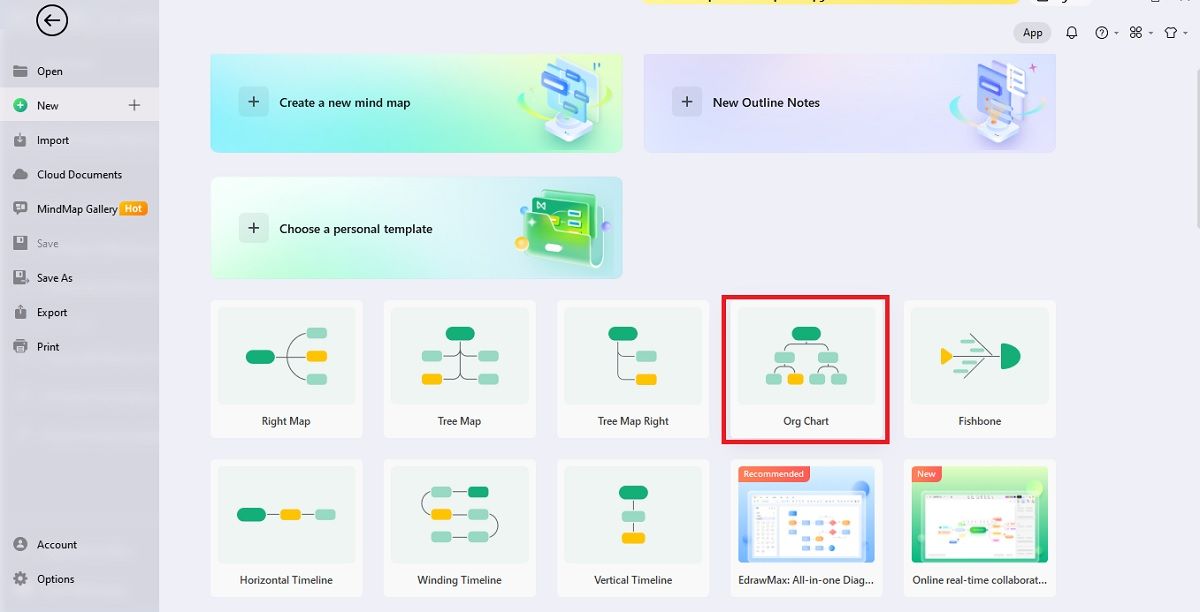
Step 2:
Use the Topic button to add positions or job titles to the chart. Start with the top-level position, such as the Site Manager, and work down the hierarchy. Click a position and enter the job title or role. Click and drag the connectors to connect the positions in the desired order. Adjust the positioning as needed to create a clear hierarchy.
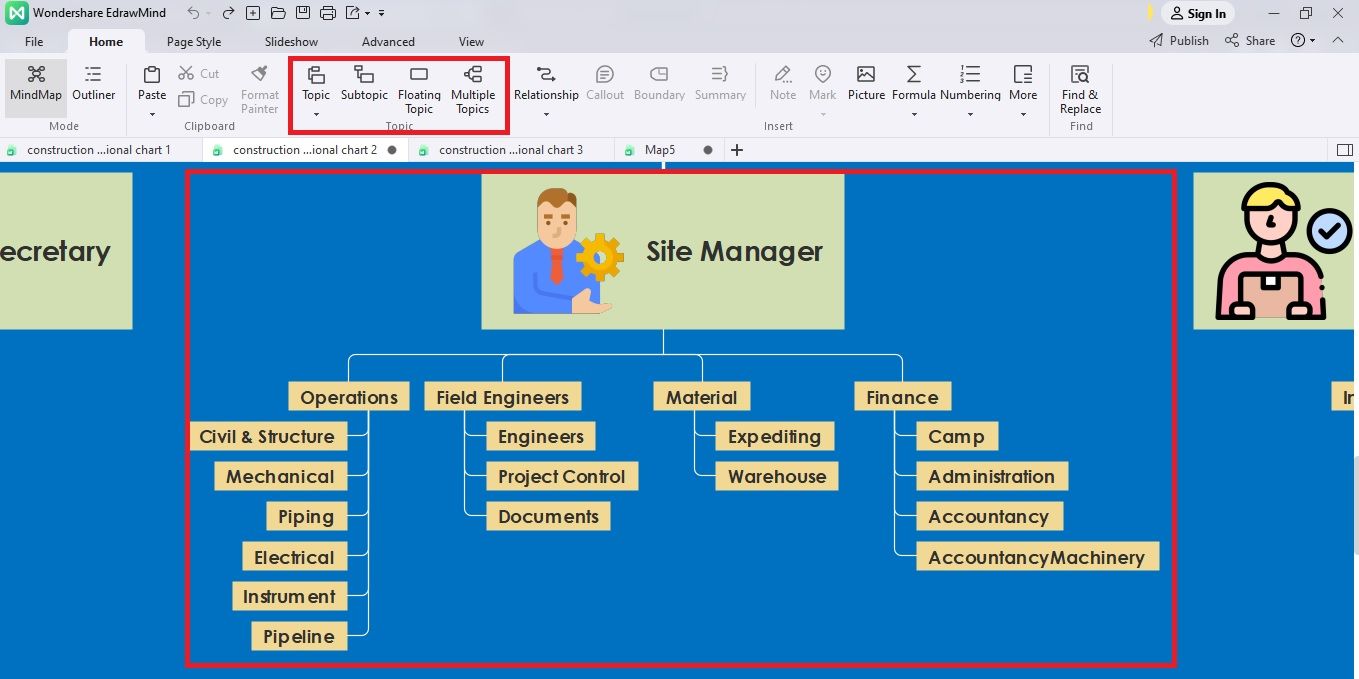
Step 3:
Double-click on each position to add additional details. Enter the name of the person holding the position, contact information, or specific responsibilities. Change the text's font, size, and color to differentiate positions.
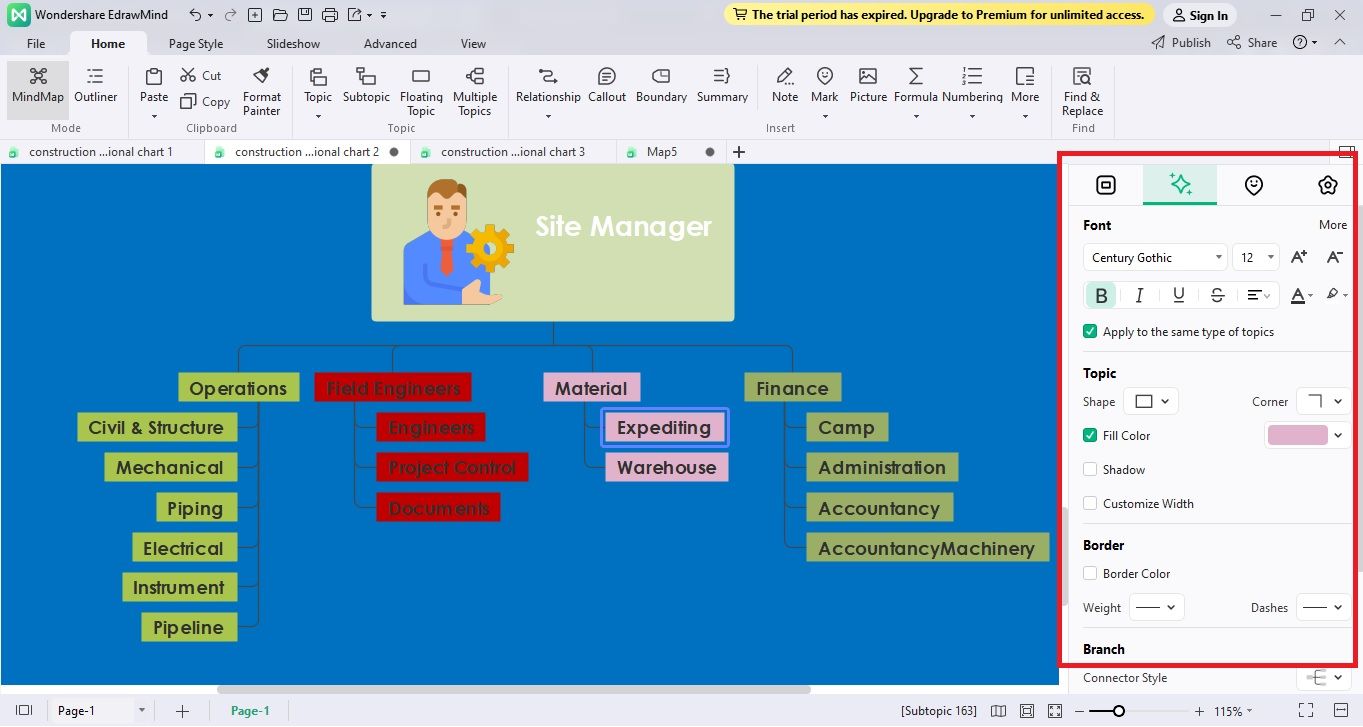
Step 4:
Save your construction company organizational chart project. Export the chart as a PDF, image file, or other compatible formats for sharing and presentation purposes.

Tips for Creating Effective Construction Company Organizational Charts
As your company evolves, new positions emerge, roles shift, or departments restructure. It's essential to review the org chart to ensure it remains aligned with the state of your company. Here are some tips for creating an effective org chart for construction companies.
1. The Importance of Accuracy and Up-to-Date Information
An org chart ensures everyone knows who reports to whom and where they fit into the company. It serves as a visual reference to understand the flow of communication. Accuracy prevents confusion and ensures employees have access to the most up-to-date information.
2. Selecting Appropriate Job Titles and Defining Roles
An effective organizational chart should have the appropriate job titles and roles. An org chart needs a clear and concise title reflecting its responsibilities and authority. Avoid using ambiguous or generic job titles that might confuse you. Defined roles help employees foster accountability and ownership within the organization.
3. The Significance of Clear Communication and Collaboration Within the Chart
A well-designed organizational chart promotes clear communication and collaboration. It streamlines decision-making and facilitates efficient communication flows. This way, employees can identify who to contact for specific matters.
Conclusion
Investing time and effort into designing a comprehensive organizational chart is important. It's vital for an efficient environment and success in the construction industry. An org chart helps ensure everyone knows their roles and responsibilities within the company.
To simplify the chart creation process, consider using EdrawMind. Its vast template library makes it easy to create professional charts in minutes. You can leverage its benefits to tailor your construction company's org chart perfectly.



